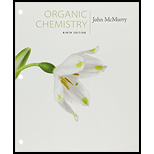
Student Value Bundle: Organic Chemistry, + OWLv2 with Student Solutions Manual eBook, 4 terms (24 months) Printed Access Card (NEW!!)
9th Edition
ISBN: 9781305922198
Author: John E. McMurry
Publisher: CENGAGE L
expand_more
expand_more
format_list_bulleted
Concept explainers
Question
Chapter 20.SE, Problem 60AP
Interpretation Introduction
Interpretation:
The synthesis of p-aminobenzoic acid starting from toluene is to be given.
Concept introduction:
The synthesis of p-aminobenzoic acid from toluene involves the following steps. i) Nitration of toluene ii) Oxidation of nitrotoluene iii) Reduction of the nitro group.
To give:
The synthesis of p-aminobenzoic acid starting from toluene.
Expert Solution & Answer
Trending nowThis is a popular solution!

Students have asked these similar questions
>
You are trying to decide if there is a single reagent you can add that will make the following synthesis possible without any other
major side products:
1. ☑
CI
2. H3O+
O
Draw the missing reagent X you think will make this synthesis work in the drawing area below.
If there is no reagent that will make your desired product in good yield or without complications, just check the box under the
drawing area and leave it blank.
Click and drag to start drawing a
structure.
Explanation
Check
?
DO
18
Ar
B
© 2025 McGraw Hill LLC. All Rights Reserved. Terms of Use | Privacy Center | Accessibility
Don't use ai to answer I will report you answer
Consider a solution of 0.00304 moles of 4-nitrobenzoic acid (pKa = 3.442) dissolved in 25 mL water and titrated with 0.0991 M NaOH. Calculate the pH at the equivalence point
Chapter 20 Solutions
Student Value Bundle: Organic Chemistry, + OWLv2 with Student Solutions Manual eBook, 4 terms (24 months) Printed Access Card (NEW!!)
Ch. 20.1 - Give IUPAC names for the following compounds:Ch. 20.1 - Draw structures corresponding to the following...Ch. 20.2 - Prob. 3PCh. 20.2 - The Ka for dichloroacetic acid is 3.32 Ă— 10-2....Ch. 20.3 - Calculate the percentages of dissociated and...Ch. 20.4 - Which would you expect to be a stronger acid, the...Ch. 20.4 - Dicarboxylic acids have two dissociation...Ch. 20.4 - The pKa of p-cyclopropylbenzoic acid is 4.45. Is...Ch. 20.4 - Prob. 9PCh. 20.5 - Prob. 10P
Ch. 20.6 - Prob. 11PCh. 20.6 - How might you carry out the following...Ch. 20.7 - Prob. 13PCh. 20.7 - Prob. 14PCh. 20.8 - Cyclopentanecarboxylic acid and...Ch. 20.8 - Prob. 16PCh. 20.SE - Prob. 17VCCh. 20.SE - Prob. 18VCCh. 20.SE - The following carboxylic acid can’t be prepared...Ch. 20.SE - Electrostatic potential maps of anisole and...Ch. 20.SE - Predict the product(s) and provide the mechanism...Ch. 20.SE - Predict the product(s) and provide the mechanism...Ch. 20.SE - Prob. 23MPCh. 20.SE - Predict the product(s) and provide the complete...Ch. 20.SE - Acid-catalyzed hydrolysis of a nitrile to give a...Ch. 20.SE - Prob. 26MPCh. 20.SE - Naturally occurring compounds called cyanogenic...Ch. 20.SE - 2-Bromo-6, 6-dimethylcyclohexanone gives 2,...Ch. 20.SE - Naturally occurring compounds called terpenoids,...Ch. 20.SE - In the Ritter reaction, an alkene reacts with a...Ch. 20.SE - Give IUPAC names for the following compounds:Ch. 20.SE - Prob. 32APCh. 20.SE - Prob. 33APCh. 20.SE - Prob. 34APCh. 20.SE - Prob. 35APCh. 20.SE - Prob. 36APCh. 20.SE - Prob. 37APCh. 20.SE - Prob. 38APCh. 20.SE - Calculate the Ka's for the following acids: (a)...Ch. 20.SE - Thioglycolic acid, HSCH2CO2H, a substance used in...Ch. 20.SE - Prob. 41APCh. 20.SE - Prob. 42APCh. 20.SE - How could you convert butanoic acid into the...Ch. 20.SE - How could you convert each of the following...Ch. 20.SE - How could you convert butanenitrile into the...Ch. 20.SE - How would you prepare the following compounds from...Ch. 20.SE - Prob. 47APCh. 20.SE - Using 13CO2 as your only source of labeled carbon,...Ch. 20.SE - Prob. 49APCh. 20.SE - Which method-Grignard carboxylation or nitrile...Ch. 20.SE - Prob. 51APCh. 20.SE - Prob. 52APCh. 20.SE - Propose a structure for a compound C6H12O2 that...Ch. 20.SE - Prob. 54APCh. 20.SE - How would you use NMR (either 13C or 1H) to...Ch. 20.SE - Prob. 56APCh. 20.SE - A chemist in need of 2,2-dimethylpentanoic acid...Ch. 20.SE - Prob. 58APCh. 20.SE - Prob. 59APCh. 20.SE - Prob. 60APCh. 20.SE - Prob. 61APCh. 20.SE - Prob. 62APCh. 20.SE - Prob. 63APCh. 20.SE - The following pKa values have been measured....Ch. 20.SE - Identify the missing reagents a-f in the following...Ch. 20.SE - Propose a structure for a compound, C4H7N, that...Ch. 20.SE - Prob. 67APCh. 20.SE - The 1H and 13C NMR spectra below belong to a...Ch. 20.SE - Propose structures for carboxylic acids that show...Ch. 20.SE - Carboxylic acids having a second carbonyl group...
Knowledge Booster
Learn more about
Need a deep-dive on the concept behind this application? Look no further. Learn more about this topic, chemistry and related others by exploring similar questions and additional content below.Similar questions
- What is the name of the following compound? SiMe3arrow_forwardK Draw the starting structure that would lead to the major product shown under the provided conditions. Drawing 1. NaNH2 2. PhCH2Br 4 57°F Sunny Q Searcharrow_forward7 Draw the starting alkyl bromide that would produce this alkyne under these conditions. F Drawing 1. NaNH2, A 2. H3O+ £ 4 Temps to rise Tomorrow Q Search H2arrow_forward
arrow_back_ios
SEE MORE QUESTIONS
arrow_forward_ios
Recommended textbooks for you
 Organic ChemistryChemistryISBN:9781305580350Author:William H. Brown, Brent L. Iverson, Eric Anslyn, Christopher S. FootePublisher:Cengage Learning
Organic ChemistryChemistryISBN:9781305580350Author:William H. Brown, Brent L. Iverson, Eric Anslyn, Christopher S. FootePublisher:Cengage Learning Introduction to General, Organic and BiochemistryChemistryISBN:9781285869759Author:Frederick A. Bettelheim, William H. Brown, Mary K. Campbell, Shawn O. Farrell, Omar TorresPublisher:Cengage Learning
Introduction to General, Organic and BiochemistryChemistryISBN:9781285869759Author:Frederick A. Bettelheim, William H. Brown, Mary K. Campbell, Shawn O. Farrell, Omar TorresPublisher:Cengage Learning Organic Chemistry: A Guided InquiryChemistryISBN:9780618974122Author:Andrei StraumanisPublisher:Cengage Learning
Organic Chemistry: A Guided InquiryChemistryISBN:9780618974122Author:Andrei StraumanisPublisher:Cengage Learning

Organic Chemistry
Chemistry
ISBN:9781305580350
Author:William H. Brown, Brent L. Iverson, Eric Anslyn, Christopher S. Foote
Publisher:Cengage Learning

Introduction to General, Organic and Biochemistry
Chemistry
ISBN:9781285869759
Author:Frederick A. Bettelheim, William H. Brown, Mary K. Campbell, Shawn O. Farrell, Omar Torres
Publisher:Cengage Learning

Organic Chemistry: A Guided Inquiry
Chemistry
ISBN:9780618974122
Author:Andrei Straumanis
Publisher:Cengage Learning